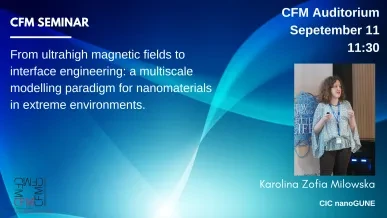From ultrahigh magnetic fields to interface engineering: a multiscale modelling paradigm for nanomaterials in extreme environments
Speaker
Karolina Zofia Milowska
Affiliation
CIC nanoGUNE
When
Place
CFM Auditorium
Host
Celia Rogero and Silvina Cerveny

Modern technologies, from renewable energy systems to aerospace hardware, require materials capable of withstanding extreme conditions while maintaining high performance. Materials are pushed to extremes of temperature, pressure, magnetic field, and radiation in applications such as solar reactors, electric motors, and satellites. Predicting material behaviour under these conditions and designing resilient alternatives is a grand challenge that multiscale modelling, especially when combined with experimental techniques, can effectively address.
In this talk, I will demonstrate how multiscale modelling provides a robust framework for bridging diverse length and time scales, revealing the behaviour of nanostructured carbon materials under extreme conditions. First, I will introduce a novel multiscale approach to magnetotransport in nanostructure assemblies, combining quantum-coherent tight-binding transport calculations (TB-NEGF), external magnetic field effects via Peierls substitution, and Molecular Dynamics (MD) simulations. This methodology, validated by experiments conducted at Los Alamos National Laboratory, allows us to interpret charge transport phenomena at magnetic fields up to 60 T and temperatures ranging from millikelvin to ambient conditions [1]. Our results illuminate how alignment and inter-tube contacts govern electrical conduction in extreme magnetic environments, guiding the design of advanced magnetoresistive composites. Next, I will present a multiscale approach designed to unravel key factors controlling chirality selectivity in cost-effective, solution-based polymer-assisted separation methods for carbon nanotubes. Integrating Density Functional Theory (DFT), MD, and Monte Carlo simulations with experimental insights enables remarkably precise control over nanotube chirality [2-5]. Additionally, I will briefly highlight the surprising amphiphilic behaviour of pristine graphene flakes at liquid–liquid interfaces, detailing their potential as surfactants for applications such as enhanced oil recovery at the seabed [6]. Finally, I will briefly touch upon our integrated modelling (DFT, DFTB, and machine-learned force fields) and experimental investigations into graphene flakes interfaced with hybrid halide perovskites. Hybrid halide perovskites - a leading class of materials for next-generation solar cells are remarkably efficient in optoelectronics but notoriously fragile: moisture, UV light, and thermal stress cause rapid degradation. These materials will serve as a showcase for modelling durability under environmental stress. Our studies indicate that atomically thin graphene-flake capping layers can significantly mitigate humidity-induced damage.
Throughout these examples, multiscale modelling acts as a powerful "virtual laboratory," enabling material testing under otherwise challenging conditions and scales. These theoretical predictions not only advance fundamental understanding but also inform practical strategies to enhance material performance. By closely integrating modelling with experiments and addressing real-world challenges, the multiscale approach accelerates the development of next-generation materials crucial for energy and space applications.
[1] J. Bulmer, C. Kovacs, T. Bullard, C. Ebbing, T. Haugan, G. Pokharel, S. D. Wilson, F. F. Balakirev, O. A. Valenzuela, M. A. Susner, D. Turner, P. Fu, T. Kulka, J. A. Majewski, I. Lebedeva, K. Z. Milowska, A. Lekawa-Raus, M. Marganska “Adjudicating Conduction Mechanisms in High Performance Carbon Nanotube Fibers” arXiv:2507.20481
[2] A. Dzienia, D. Just, T. Wasiak, K. Z. Milowska, A. Mielańczyk, N. Labedzki, S. Kruss, D. Janas “Size Matters in Conjugated Polymer Chirality‐Selective SWCNT Extraction:, Advanced Science, 11 2402176 (2024)
[3] D. Just, A. Dzienia, K. Z. Milowska, A. Mielanczyk, D. Janas “High-yield and chirality-selective isolation of single-walled carbon nanotubes using conjugated polymers and small molecular chaperones”, Materials Horizons, 11(3), 758-767 (2024).
[4] A. Dzienia, D. Just, P. Taborowska, A. Mielanczyk, K. Z. Milowska, S. Yorozuya, S. Naka, T. Shiraki, D. Janas “Mixed‐Solvent Engineering as a Way around the Trade‐Off between Yield and Purity of (7, 3) Single‐Walled Carbon Nanotubes Obtained Using Conjugated Polymer Extraction”, Small, 19 (46), 2304211 (2023).
[5] P. Tiwari, B. Podlesny, M. Krzywiecki, K. Z. Milowska, D. Janas “Understanding the partitioning behavior of single-walled carbon nanotubes using an aqueous two-phase extraction system composed of non-ionic surfactant and polymer”, Nanoscale Horizons, 8 (5), 685-694 (2023).
[6] A. W. Kuziel*, K. Z. Milowska*, P.-L. Chau, S. Boncel, K. Koziol, N. Yahya, M. C. Payne “The True Amphipathic Nature of Graphene Flakes: A Versatile 2D Stabilizer”, Advanced Materials, 32, 2000608 (2020).
